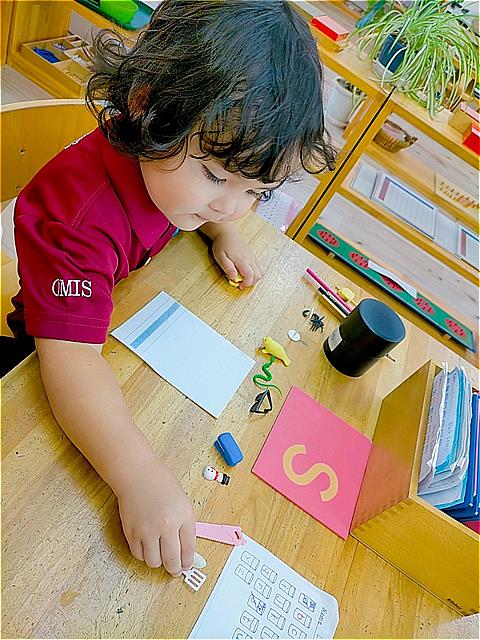Educational Policy
English Acquisition is not the Primary Objective
Our school's primary goal is to introduce the benefits of Montessori education to Japanese children. Therefore, English proficiency is not our primary goal. While all curriculum activities are conducted in English and include learning phonics, reading, writing, understanding science, and geography in English, children are not corrected for speaking Japanese. We do not offer preparation for English proficiency tests. In households where Japanese is the mother tongue, we advocate for the use of Japanese language at home.
Understanding the Child's Behavior
Even behaviors such as repeating one activity and showing no interest in others have reasons behind them. By carefully observing whether a child wants to master a particular activity or has other reasons for repeating it, we can understand why they do so. Providing help based on the child's behavior helps them gain confidence in their understanding and motivates them to progress further. This is why we have unique educational materials to support individual needs.
Curriculum Implementation Based on Age
In Montessori education, curricula are broadly tailored to age-appropriate levels, incorporating the following:
We assist in various forms of education such as mimicking various actions that adults do on a daily basis, using the tools available in the home and various needs of toddlers who are interested in them, making small noises, moving to touch objects, and stimulating interest in external stimuli such as colors and sounds, etc. Let me explain one by one.
①Practice of Daily Life
Growing through Mimicking Adults
Toddlers in the Toddler class are particularly fond of using everyday items in the home as teaching materials. This is because toddlers have a desire to use what is familiar to them. Watering, taking out the contents, fitting, pinching, pushing in, shaking, etc., cannot try all the tools at home, but here you can use as much as you like.

②Sensorial Education
Developing Concentration through Immersion in Interests
In Montessori education, teachers are not "teachers" who teach, but human environmental elements that observe children and assist them in self-directed activities. This point is the most distinguishing feature from other educational methods. Children concentrate on tackling the tasks they choose and achieve them to gain confidence. The most important thing is to guarantee the freedom for children to engage in spontaneous activities. Children will develop a sense that cannot be experienced in an environment where concentration is interrupted by teachers and adults.

Education through a Prepared Environment
- Environment configuration that allows children to freely choose teaching materials.
- Interesting teaching materials that make you want to try.
- Formation of mixed-age classes with a range of 3 years to promote social and cooperative skills.
- Teachers who prepare an environment appropriate for each child's developmental stage and assist in the child's self-formation.
When you visit, you may be surprised at the spacious and tidy environment. Montessori's unique teaching tools, which use various materials such as wood and cloth, as well as everyday tools, ensure that children return the tools to their original state to make them easy for the next person to use. This is a promise to use tools, and all children use them quietly without being forced by anyone to clean them up neatly after they finish their work.

③Mathematics EducationMathematics
Progressing from Concrete to Abstract Understanding
The distinctive feature of Montessori mathematics education is to understand from tangible things to abstract ones. They transition gradually from repeated imaging while repeating images. The reference image is the famous Montessori-specific bead teaching aid. In addition to addition and subtraction, they understand multiplication, division, fractions, and decimals as they continue to understand them.

Understanding the Shape Items
There are teaching materials to understand the length of edges and the relationship of volume of visual and sensory shapes such as "Pink Tower", "2-Term Cube", and "3-Term Cube". In fact, this is something that is studied in junior high school mathematics called "Binomial Algebra", but children will naturally acquire it first by understanding it from the image.。

④Language Education
Tools appropriate for development stages
In addition to daily use of the mother tongue other than the mother tongue, foreign languages are difficult to learn by random and indiscriminate teaching, even for adults. We use teaching materials appropriate for each stage of development such as picture cards and letter cards. By aiming to enrich vocabulary through the work of "Talk," "Read," "Write," and ultimately to grammar and sentence construction, mainly starting from CH classes, there are many word-related activities.

Emphasizing Experience, Sensation, and Sensibility
Because just seeing letters and words is abstract and meaningless, we go through steps to give it meaning. Montessori leads children's thinking in stages of "from sensation and sensation to abstract" through concrete experience and experience. For example, at the beginner's stage of the image, there is a pink box (pink level) with a,e, I,o,u vowels written on it, and objects corresponding to vowels are prepared. There are also curricula such as "Building words" where you place one alphabet at a time and place an object next to it.

⑤Cultural EducationCultural Studies
Valuing Curiosity and Excitement
While observing various everyday items such as insects and animals brought by children, indoor plants, flowers, vegetables, and various cultural studies such as history, geography, music, and art, the curiosity brought by children is used in various curricula, such as drawing pictures and observing them.


